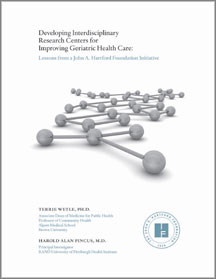 There are no more Marcus Welbys. The days when a single physician could deliver the majority of care for a sick older person are long gone. Today, health care providers recognize the reality that older patients present a wide and complex variety of needs that often traverse the boundaries between health disciplines. That goes along with the recognition that quality care means treating the patient, not the disease. When an 80-year-old woman shows up in an emergency room complaining of severe back pain but can’t afford her co-pay, doesn’t remember her husband’s name, and looks as if she hasn’t eaten that day, Dr. Welby needs to call for help. It’s going to take a team.
There are no more Marcus Welbys. The days when a single physician could deliver the majority of care for a sick older person are long gone. Today, health care providers recognize the reality that older patients present a wide and complex variety of needs that often traverse the boundaries between health disciplines. That goes along with the recognition that quality care means treating the patient, not the disease. When an 80-year-old woman shows up in an emergency room complaining of severe back pain but can’t afford her co-pay, doesn’t remember her husband’s name, and looks as if she hasn’t eaten that day, Dr. Welby needs to call for help. It’s going to take a team.
The first challenge, of course, is that coordinating services across the different professions can be extraordinarily difficult. How do we harmonize care and services and communicate, coordinate, and collaborate to promote the best health outcomes? We need interdisciplinary research to give us answers.
That kind of research comes with its own set of complexities. To begin with, a large number of disciplines, including healthcare and non-medical, need to contribute— medicine, nursing, social work, anthropology, nutrition, biostatistics, pharmacy, business, psychology, dentistry, public health, economics, public policy, education, rehabilitation, engineering, religious studies, law, and sociology, to name some of them. Effective communication among these groups is often daunting. They speak different languages and use different methodologies. Institutional barriers and departmental structures and culture may get in the way of successful research.
Yet interdisciplinary research is vital if we are to meet the challenges of our aging demographic. Because of these complexities, as well as the need to develop effective and efficient models for geriatric care, the John A. Hartford Foundation collaborated with the RAND Corporation in launching a two-phase initiative, Building Interdisciplinary Geriatric Health Care Research Centers. Its purpose was to create both an infrastructure and incentives that would encourage and facilitate interdisciplinary research.
The initiative, launched in 2004, granted each of 12 research centers across the country $200,000, complemented by a 50 percent institutional match. The centers primarily used the funding to support pilot projects, provide advanced learning opportunities for junior faculty, create mentoring programs, and initiate various activities to enhance interdisciplinary research.
The results proved extraordinary. Work at participating centers yielded 1,248 accepted manuscripts, 678 conference presentations, and 240 new funded grants. It also revealed important lessons for those interested in pursuing similar research.
In order to foster successful interdisciplinary research, the Hartford Foundation is proud to announce the publication of a report on the project, Developing Interdisciplinary Research Centers for Improving Geriatric Health Care: Lessons from a John A. Hartford Foundation Initiative, authored by Terrie Wetle, PhD, associate dean of medicine for public health and professor of community health at Alpert Medical School, Brown University; and Harold Alan Pincus, MD, principal investigator, RAND University of Pittsburgh Health Institute.
We’d like to invite all of you with an interest in furthering geriatric research to understand the lessons we learned through this project, in the hope that it will foster critically needed interdisciplinary research.
